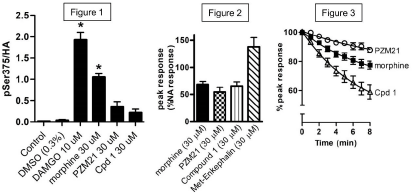Print version
Search Pub Med
- S. Groom1
- A. Conibear2
- A. Disney1
- S. Husbands1
- Y. Li3
- L. Toll4
- G. Henderson2
- E. Kelly2
- C. Bailey1. 1Department of Pharmacy & Pharmacology
- University of Bath
- Bath
- United Kingdom
- 2School of Physiology
- Pharmacology & Neuroscience
- University of Bristol
- Bristol
- United Kingdom
- 3Torrey Pines Institute for Molecular Studies
- Port St. Lucie
- FL
- 4Florida Atlantic University
- Boca Raton
- FL
| 046P Nottingham, UK 7th Focused Meeting on Cell Signalling |
Exploring rapid desensitization of mu-opioid receptors induced by G protein-biased agonists
Introduction: G protein-biased agonists of mu-opioid receptors (MOPrs) have potential for reducing receptor desensitization and drug tolerance. We have studied 2 potential G protein-biased MOPr agonists: PZM211 and ‘Compound 1’ (Tyr-c[D-Lys-Phe-Tyr-Gly])2. Using Western blotting we investigated each agonist’s ability to phosphorylate a GRK substrate on MOPr (Ser375), and using brain slice electrophysiology we have investigated each agonist’s ability to induce rapid MOPr desensitization.
Method: Western blot: HEK293 cells stably expressing the HA-tagged rat MOPr were incubated with MOPr agonists for 10 min at 37oC. HA-MOPrs were immunoprecipitated using anti-HA antibody, proteins were resolved by SDS PAGE. Changes in receptor phosphorylation were evaluated by phosphor-serine 375 immunoblotting3,4. Electrophysiology: Whole-cell voltage-clamp recordings were made from rat locus coeruleus (LC) neurones (from 4-5 week-old male Wistar rats). MOPrs are coupled to K+ channels: the amplitude of K+ current is a measure of MOPr activation. α2-adrenoceptors couple to the same channels as MOPrs: comparing MOPr-evoked currents with noradrenaline (NA)-evoked currents gives a measure of MOPr agonist efficacy3. Data shown as mean±SEM. Statistics: 1-way ANOVA or unpaired Student’s T-test, as appropriate.
Results: Morphine and DAMGO both induced Ser375 phosphorylation3,4. In contrast, PZM21 and Compound 1-induced Ser375 phosphorylation was indistinguishable from control (Figure 1; n=3). In rat LC neurones, peak K+ currents induced by morphine, PZM21 and Compound 1 were similar, and significantly less than Met-Enkephalin, indicating that PZM21 and Compound 1 have similar efficacies to morphine (Figure 2; n=5-7). Over 8 minutes, PZM21 induced significantly less rapid MOPr desensitization than morphine. In contrast, Compound 1 induced robust MOPr desensitization that was significantly greater than morphine (Figure 3; n=3-7; each applied at 30μM). Further, although activation of PKC has been shown to enhance morphine-induced MOPr desensitization5, the phorbol ester PMA (1μM) did not significantly affect PZM21-induced MOPr desensitization (PZM21 current at 8 minutes: 87.8±1.7% (control), 82.2±3.8% (in PMA) (n=3-5).

Conclusion: These data indicate that although potential G protein-biased agonists at MOPrs induce very little phosphorylation of Ser375, their abilities to induce rapid MOPr desensitization can vary. Subsequent experiments are ongoing to investigate the intracellular mechanisms involved, and the in vivo consequences.
References:
1. Manglik A et al. (2016). Nature 537:185-90.
2. Li Y et al. (2016). J Med Chem 59:1239-45.
3. Lowe JD et al. (2015). Mol Pharmacol 88:347-56.
4. Schulz S et al. (2004). EMBO J 23:3282-9.
5. Bailey CP et al. (2009). Br J Pharmacol 158:157-64.

